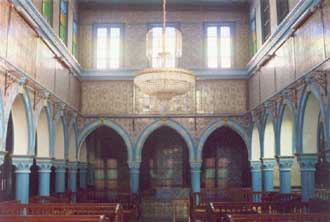 |
| Interior of El Ghriba Synagogue |
Djerba is an island off the coast of southern , 500 km (300 miles) from the capital Tunis
In ancient times Djerba was an important trading center. According to the local tradition, the first may have come from about 3,000 years ago, at the time of and , or at the time of the destruction of the and the forced in 586 BCE. They were probably joined by the Jews who fled after the in 70 C.E. and others who ran from the . They settled in two separate communities: Hara Kabira (the large Jewish quarter) and Hara Saghira (the small Jewish quarter).
The priestly who escaped from Jerusalem in 70 CE settled in Hara Saghira, and their descendants still live there today. According to tradition, the absence of Levites on the island is the result of a curse against them by because they refused to answer his request to send Levites to (cf. ), and they all died.
The history of the Jews of Djerba includes three serious persecutions: in the 12th century under the ; in 1519 under the Spanish; and in under the . In 1239, a colony of Jews from Djerba settled in , where they obtained concessions to cultivate henna, indigo, and the royal palm groves. It was common for the male Jewish population of Djerba to look for livelihood abroad, but they kept returning to the island, where their families had remained. The exchange of goods with and was in the hands of the Jews, who grew the products and processed the commodities for export themselves. , in a letter to his son, expressed a low opinion of their superstitions and spiritual capacity but praised them for their faith.
In the 19th and 20th centuries, the of Djerba produced many and writers, and they provided rabbis for the communities of North Africa. In 1976, some 300 youngsters received a Jewish education. In the early 1990s, the provided funding for Jewish education (including a girls’ school) with a combined enrollment of 245. David Idan established a press in Djerba in 1903, and many books, mainly PassoverHagaddot and liturgical items, were printed there. The Djerban Jews are famed for their filigree jewelry, and many today still work as gold and silversmiths.
In 1946, about 5,000 of Tunisia’s 105,000 Jews lived in al-Ḥara al-Ṣaghīra, al-Ḥāra al-Kabīra, and Houmt-Souk, the principal town of the island. Their number dwindled with most to and settling in (many of them on moshav Eitan) when the state was founded, and others leaving during periods of fear and insecurity, such as the , the , and the government’s brief stint with nationalism in 1969-70. Many French-speaking Jews also moved to France, and by 1993, only 670 Jews lived on the island, and the Jewish neighborhoods lost their purely Jewish character as moved in.
The community rebounded, and today, 1,100, 75% of Tunisia’s 1,500 remaining Jews, live on the island with 175,000 Muslims. The Jews dress exactly like their Muslim neighbors – the men in red felt hats, tunics, and pantaloons and the women in long dresses and head-coverings, while the younger generation dresses in Western-style garb. The only distinguishing feature is a narrow black band at the bottom of the men’s pantaloons, a sign of mourning for the destruction of the Temple.
Tunisian Jews typically speak French; however, those in Djerba speak a local Judeo- dialect, which is written in Hebrew characters. They proudly identify as . There are several kosher restaurants with signs in Hebrew, Arabic, and French.
The children’s first language is Arabic, but they learn the and basic Hebrew prayers at a day school. By eight or nine years old, Djerba boys are undertaking serious studies at a yeshiva.
Because they lived in virtual isolation from the rest of the world until the advent of 20th-century mass tourism, the Jews of Djerba have been able to preserve a very undiluted form of Judaism. The whole community is religiously observant and maintains 12 different (some are only open on holidays). Once a month, a minyan stays up all night studying and praying. Boys and girls do not meet alone before they are married, and even older men and women are rarely seen in public together. The conservative, traditional Jews of Djerba are fairly insular, keeping themselves apart from other and abroad. Their spiritual leader is Chief Rabbi Haim Bitan.
The most famous synagogue in Tunisia, and the oldest in Africa, is the El Ghriba synagogue in the village of Hara Sghira on Djerba. The current building was constructed in the late 19th or early 20th century, but the site is believed to have had a synagogue on it for the past 1,900 years. The restored white building with its ornate interior is only about a century old, but it is built on the foundations of all the Ghribas that preceded it. The many legends that circulate about El Ghriba say that its foundation stone, or perhaps a gate, came from Solomon’s temple.
The Guellela Museum has displays on the island’s culture, including exhibits on Jewish religious practices and customs. The Museum, Ivri said, “conveys an overlying message that is promoted by the government and many of the Muslims I would encounter…the Jews among us are part of the Tunisian nation, only different by their religion.
Continued at https://www.jewishvirtuallibrary.org/djerba
_______________________
SEE ALSO: https://aish.com/the-jews-of-djerba-9-facts-about-this-ancient-jewish-community/
AND: In this (timesofIsrael) Photo Essay you can see 20 photos of life in Djerba: https://www.timesofisrael.com/photo-essay-ancient-jewish-community-endures-on-tunisian-isle/


No comments:
Post a Comment